Dick Brooks, Concord, MA
With the passing of David Leach in April 1998, the genus Rhododendron lost one of its principle champions, and rhododendron enthusiasts everywhere lost a real friend and mentor. David would be remembered for his monumental book Rhododendrons of the World alone, but his boundless energy and enthusiasm found outlets also in an outpouring of articles, many of them for the Society's Quarterly Bulletin and Journal, in a major testing and evaluation program at his garden in Ohio, in many research projects, in a lecture circuit worldwide, and in extensive breeding activity, which resulted in a bewildering array of rhododendron cultivar introductions.
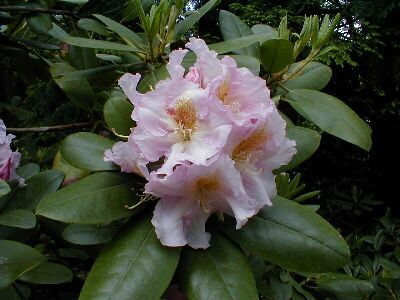
It has become fashionable among some rhododendron cognoscenti to express disdain, or even outright contempt, for the Leach introductions. Various reasons are cited: faults in plant habit, mediocre performance, lack of flower quality, and so on. In the case of certain cultivars, some criticism may indeed be justified. But it must be remembered that David was breeding and selecting plants for his own area of the Midwest, not for New England. I have seen magnificent specimens in his Ohio garden, while the same cultivar here in my Massachusetts garden languishes or develops a rangy habit.
I have been growing some fifty-seven of the Leach hybrids in my Zone 5b garden, some for as long as 30 years, and in my opinion there are many first-rate plants among them. What follows is a personal assessment of all the Leach plants that I have grown, based on my own experience with them. For purposes of comparison, I've grouped these into several categories, based on plant and flower characteristics. I have also given a numerical rating to each cultivar, using the old ARS rating designation, in which the flower, plant/foliage, and overall performance are rated by a number from l (poor) to 5 (superior). It should be emphasized that these ratings are by no means "official", but simply my own evaluation of the plants' appearance and performance in my own garden.
Full Size Plants with White Flowers
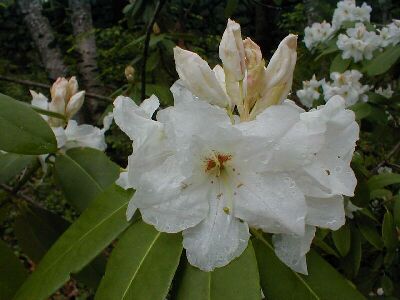
'Lodestar' A.E. and 'Swansdown' A.E. are among the earliest introductions (1965-1966) from David's breeding program, and are from the same parents ('Belle Heller' and white R. catawbiense). They form tall, wide-spreading, rangy plants; 'Swansdown' has somewhat more regular branching, resulting in a denser habit. Both are dependably floriferous year after year, budding at almost every terminal. The flowers, opening from pale lilac-colored buds, are white with a bold yellowish-green dorsal flare. They have the typical catawbiense form, but are considerably larger than the familiar "ironclad" hybrids, and the trusses of 15 to 20 flowers are quite impressive. My ratings: 'Lodestar' 3/2/4; 'Swansdown' 3/3/4
Another pair of siblings is 'Applause' and 'Finlandia' [catawbiense 'Catalgla' x ('Adrian Koster' x williamsianum)], introduced in 1972-1974. These are medium tall growers, forming well-branched, fairly dense plants. 'Finlandia' has uniquely shaped leaves, convex with a pronounced downward turn, that give it a "what's-that-strange-looking-plant?" appearance. Both varieties have good-sized, wide open, pure white flowers, with a slight shading of ivory in the center, in trusses of 10 to 12 flowers. My ratings: 'Applause' 4/3/3; 'Finlandia' 3/3/3.
Introduced about the same time, but from quite a different line of breeding [white catawbiense x fortunei x (arboreum x griffithianum)}] is 'Dolly Madison'. As might be expected from its pedigree, this is a lusty, vigorous plant that can easily reach 5 or 6 feet at 10 years of age. The very large flowers open the palest of pinks and quickly fade to white. My rating: 4/3/3.
Also dating from 1972 is 'Nepal' [white catawbiense x (wightii x fortunei)]. Although this is reported to reach an ultimate height of 15 feet, my plant, now 12 years old, has tended to be more spreading in habit: less than 5 feet tall but close to 7 feet across. It has impressive, substantial foliage now, but in its earlier years here the leaves tended to be somewhat chlorotic. I suspect this was a juvenile characteristic, now outgrown, because I have neither fertilized the plant nor attempted to correct the soil pH. The large fortunei-type flowers open from pink buds. My rating: 4/3/4.
Yet another mating of white catawbiense, this time with the pale yellow-flowered 'Goldfort', resulted in 'Luxor' A.E., introduced in 1973. A medium sized plant, 'Luxor' bears flowers sometimes described as yellow; they are actually ivory or cream-colored, presented in a full truss. My rating: 4/3/3.
If all the Leach hybrids in the white-flowered category, my vote for the "best in class" goes to 'Edmond Amateis' (white catawbiense x Dexter seedling), introduced in 1969. This is a big, vigorous, well-branched, well-foliaged shrub, of almost ironclad hardiness. Unlike the ironclads, however, it bears large (3 ½ inch) flowers of classic fortunei form, held in upright trusses of impeccable bearing. They are a snowy white, whose purity is emphasized by a small flash of red in the center of each flower. About the only desirable feature it lacks is fragrance. My rating: 5/4/4.
Full Size Plants with Pink Flowers
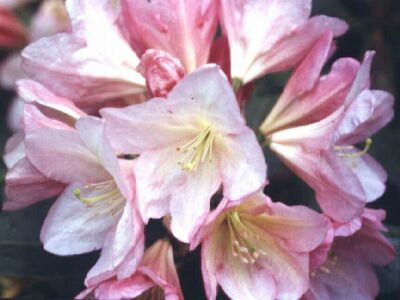
From the same parents as 'Dolly Madison' came 'Bravo!', introduced in 1974. A similarly robust plant, 'Bravo!' was described by Leach himself as "a huge, blowsy, Rubenesque sort of rhododendron with buxom trusses of not very distinguished carriage". Despite that assessment, 'Bravo!' is of ironclad hardiness, and the light pink trusses are indeed huge for a hardy rhododendron. After 15 years in my garden, the sturdy, well-branched plant is towering over its neighbors, at 10 feet in height and spread. My rating: 3/3/4.
A trio of popular cultivars resulted from the cross of 'Mrs. Furnival' x white catawbiense: 'Cyprus', 'Persia' A.E. and 'Party Pink' S.P.A. Introduced from 1973 to 1983, all three are vigorous, floriferous plants; the two latter grow taller than 'Cyprus' and tend to become somewhat leggy with age. The blossoms of 'Cyprus' open almost white from pink buds, with a strong reddish flare that dissolves into speckling at its margins. 'Persia' has flowers of very pale pink with a greenish-yellow flare. The deepest colored of the three, 'Party Pink', sports cotton-candy pink trusses with less conspicuous coppery speckling; this is one of the very few plants to have received the coveted Superior Plant Award from the ARS. My ratings: 'Cyprus' 3/3/3; 'Persia' 3/3/3; 'Party Pink' 4/3/3.
From a cross by Tony Shammarello ('Cunningham's White' x red catawbiense hybrid), Leach raised 'Vernus' and introduced it in 1957. Notable for being one of the earliest flowering elepidotes, 'Vernus' blooms here in early May, and in late April in milder climates. The blossoms are a clean light pink, without purple overtones, and of typical catawbiense form. However, the plant habit leaves something to be desired, rather open and leggy. Perhaps a sunnier spot than I had for it would produce a shapelier plant. My rating: 3/2/3.
Perhaps the hardiest rated (-30°F) of all the Leach elepidote introductions is 'Pink Flourish' [white catawbiense x {(decorum x griffithianum) x catawbiense hybrid}]. Introduced in 1962, this is another vigorous but somewhat leggy plant that looks well in a woodland setting but less so in a more formal shrub border. It is dependably floriferous, year after year, with trusses of large flowers that open a vivid purplish-pink, and age gracefully to a more subdued light pink with deeper edges. My rating: 3/2/3
'Ballad' and 'Madrid' are both from the cross Dexter #1 x 'America', but were introduced eleven years apart, 1972 and 1983, respectively. As might be expected from the pedigree, 'Madrid' forms a rather open, leggy plant; my plant of 'Ballad' is still too young to evaluate. The flowers of the two siblings are similar in form: large, open and fortunei-shaped, but quite distinct in color. Those of 'Ballad' are a light purplish-pink, edged slightly deeper, while those of 'Madrid' are a more intense deep pink, still on the purplish side. Both have a prominent reddish flare in the throat. My rating for 'Madrid': 3/3/3.
Curiously unlike its parents in both habit and flower color is 'Rio', introduced in 1983. Its putative pedigree is 'Newburyport Beauty' x 'Newburyport Belle'; both parents are Dexter hybrids, and have the typical Dexter vigor and open habit, and both have flowers in undistinguished shades of lavender pink. Yet this offspring forms a neat, compact plant, only 4 feet tall and 5 feet wide after 9 years in my garden, and even more surprising, the blossoms are an ingratiating shade of salmon-pink, seemingly lit from within by a golden glow in the center. My rating: 4/4/3.
Possibly the most popular (and deservedly so) of all David's introductions is 'Janet Blair', introduced in 1962. Of unknown parentage, but probably including some Dexter blood, this has proven to be a star performer through large areas of eastern North America. It forms a vigorous, well-branched plant with superb foliage; a mature specimen will need plenty of space, but is well worth the area devoted to it. The very large, ruffled flowers are a pale pink ("negligee pink", according to one nurseryman) with a prominent yellowish flare. 'Janet Blair' is just one of those happy garden subjects that knows its job and proceeds to perform it in a thorough and enthusiastic manner. My rating: 5/4/5.
I give 'Bali' similar high marks, although it is quite different in stature and flower from 'Janet Blair'. From the cross [white catawbiense x {(neriiflorum x dichroanthum) x fortunei ssp. discolor}], 'Bali' was introduced in 1974. My plant, now 12 years old, is a dense mound of deep green foliage, 4 ½ feet tall and 7 or 8 feet wide. The flowers, elegantly simple in form and held in trusses of about 15, are a delicate light pink with a deeper reverse. A suffusion of pale yellow in the center of each flower gives the impression that the truss is illuminated from within. 'Bali' is altogether a superb plant, among the best in my garden. My rating: 5/5/5.
Plants with Flowers in Pastel Blends
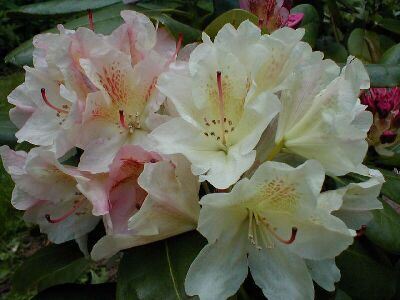
From the same cross as 'Bali' is 'Nuance', introduced in 1968. It makes a similarly dense, well-foliaged plant, but more upright in habit. It has been a shy bloomer for me, setting just a few buds for the first time after 11 years in the garden. The flowers open a light pink with a suffusion of yellow in the center; they fade to almost white, with the barest hint of pink at the petal margins, but retain the yellow shading. My rating: 4/4/2 (the low third figure only because of the paucity of bloom).
A trio of cultivars, 'Bangkok', 'Duet' and 'Monaco' resulted from a single 1952 cross [white catawbiense x {dichroanthum x (griffithianum x auriculatum)}]. Introduced, respectively, in 1972, 1961 and 1984, all three offer flowers in a similar palette: pale yellow centers with broad edging of light pink. All three age considerably paler, 'Duet' in particular ending up almost white. 'Monaco', showing the auriculatum influence, is supposedly the latest to bloom, but this past spring (1998, an unusually early season, to be sure) it was in full flower for me the third week in May. Plant habit in all three is reasonably dense and well-behaved. My ratings: 'Bangkok' 3/3/3, 'Duet' 3/4/3, 'Monaco' 3/3/3.
'Hindustan' is a 1983 introduction from the cross [(maximum x 'Goldsworth Orange') x ('America' x 'Gertrud Schale')]. It is a prime example of a handsome flower (if and when it decides to bloom) on a perfectly terrible plant. Gangling and awkward, my plant at 12 years old had reached mature dimensions of 7 feet high and as wide, but still exhibited awkward adolescence in habit, and it had not yet favored the garden with a single blossom. Finally in 1996 this leggy monster deigned to set a grand total of 3 buds. Indeed, the flowers are rather spectacular, a luminescent shade of soft orange which on closer examination is seen to be made up of a buff-yellow background suffused throughout with pale pink. Perhaps a heavy flowering, with trusses on every terminal, would suffice to forgive the plant its wayward tendencies, but until that happens, my rating is 4/1/2.
With a plant habit just as straggling, and a flower far less comely, 'Shanghai' has even less to commend it. Introduced in 1973, 'Shanghai' [('Mrs. Furnival' x white catawbiense) x an unnamed seedling, mauve with gold blotch] in my garden is now a mature 16 years old, but has not outgrown its bad adolescent habits. The flowers are white flushed pink at the edges, which might be attractive if it stopped there, but the effect is spoiled by a large and prominent greenish blotch. Not surprisingly, my rating is 2/1/2.
It's a relief to report that the next plant in this category is, at least in an early evaluation, a winner. 'Casanova' ['Newburyport Belle' x (white catawbiense x wardii)], introduced in 1985, is proving, after 7 years in my garden, to be a neat, well-mannered plant with an exceptional floral display. Widely touted as a hardy yellow, growers who acquire it and watch expectantly for the first flower are quite sure they have been sent the wrong plant, for the expanding buds are a vivid coral-red. The perplexing pigment rapidly dissipates after the flowers open, however, leaving a unique shade of buff-yellow highlighted with prominent coppery speckling on the upper lobe. (The story goes that David had not initially planned to release 'Casanova', but simply regarded it as a stepping-stone for further breeding; he used its pollen on a vast harem of other plants, thus earning it its name!) My rating (tentative): 5/4/4.
Another plant with a good deal of promise is 'Trinidad' ('Calcutta' x 'Tahiti'), introduced in 1982. After 8 years in the garden here, the plant is still only 2 feet tall, a slow, dense grower. It is not yet what I would call generous in bloom, but the flower is so unique it is well worth waiting for. From reddish buds, the developing flowers lose the red coloration, turning a pale ivory or cream except for a sharply defined edging of the same cherry red—a real show-stopper. My rating (tentative): 4/4/3.
Finally, a relatively new introduction, 'Santa Fe', provides a color accent virtually unknown until now in colder climates. From the cross ['Limelight' x {('King of Shrubs' x smirnowii) x 'Limelight'}], 'Santa Fe' blooms in a unique shade of orange-pink with cream shading and a center of deep red. The plant habit seems full and dense. Although I have had the plant for only a year, I'm ready to assign a tentative rating of 4/4/3.
"YAK" Hybrids
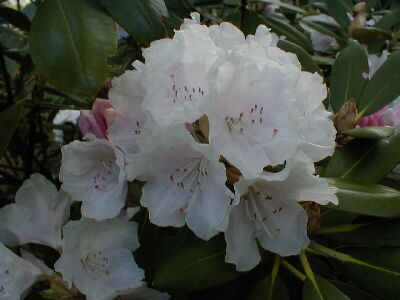
Like so many other hybridizers, David was keenly aware of the benefits of introducing genes from R. yakushimanum (now properly R. degronianum ssp. yakushimanum) into his breeding program. Its dense, compact plant habit, excellent foliage and foliage retention, and hardiness are all desirable traits to be passed on to its progeny. Among his earliest introductions (early 1960's) are several siblings from the cross (white catawbiense x yakushimanum). 'Anna H. Hall' has graced my garden for a quarter century, and although it is now leggy from being shaded out by taller plants around it, in its early years it did maintain a fine, compact habit. The abundant flowers are typical "yak" in color, pink buds opening white. I rate this and the very similar 'Spring Frolic' at 3/4/4.
From a 1962 cross (smirnowii x yakushimanum) by Ben Lancaster of Camas, Washington, Leach in 1976 introduced 'Crete'. Like other plants from this cross, 'Crete' is a good, vigorous grower that maintains a dense, well-branched habit and superb, heavily indumented foliage. Bright magenta-rose buds give promise of a colorful display, but the "yak" influence predominates and the flowers quickly turn white shortly after opening. I understand from some growers that fall bloom is a problem with this cultivar, but this has not so far been the case with my plant. My rating: 3/4/4.
Full Size Plants with Red Flowers
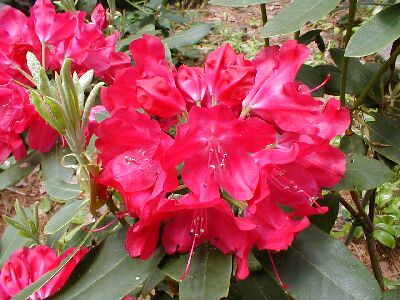
One of the first to be introduced (1976) in this category was 'Fiji', from an unlikely cross of 'Russell Harmon' x 'Goldsworth Orange'. The plant habit is low and spreading—I might say almost sprawling—and the flower is an interesting shade of light red ("claret-rose", according to one description). Its late flowering (early June for me) is a plus. My rating: 3/2/3.'Burma' is one of those plants that I saw putting on a splendid show in David's own garden in Ohio, but for me has been a dismal failure. Unable to hold up their heads, the new shoots flop over, and wind up creeping along the ground. This might be a virtue if I were looking for a ground cover plant. But the plant is deplorably stingy with bloom: in the ten years I have owned it, it has bloomed only once, and with only a single truss, albeit of a good dark red. Understandably, my rating is 2/1/2.
Two plants still too young to evaluate are 'Bikini Island' and 'Samoa'. Neither has yet bloomed. 'Bikini Island' at five years old seems destined to become a narrow, upright plant. Look for a full report in a couple of years.
Low Growing Plants with Red Flowers
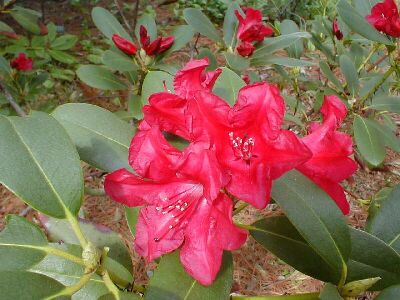
As a group, these have been less than successful for me. At least four of them, 'Flamenco', 'Rangoon', 'Singapore' and 'Small Wonder' are siblings, from the cross 'Fanfare' x 'Gertrud Schfile'. Another, 'Sumatra', is from the cross 'America' x 'Gertrud Schale'. Yet another, 'Ravenna', from the cross ['Scarlet Blast' x {(white catawbiense x yakushimanum) x ('Fanfare' x 'Gertrud Schale')}], is still too young to evaluate. All feature flowers in shades of clear red, largely free from the purple cast which flaws so many hardy reds.
Probably the best of the group in my garden is 'Small Wonder'. It blooms reliably, with medium-sized tresses of a fairly dark red. My plant's habit is open and somewhat leggy, but this I attribute to its being overshadowed by a huge overgrown Ilex crenata for the first seven years of its life. 'Singapore' is almost as good, although it has a tendency to produce a late flush of growth which features unattractive congested foliage around the flower buds. My rating for both: 4/3/3
'Flamenco' and 'Sumatra' are a different story. Both developed into weak, spindly, sprawling specimens, with an inordinate attraction for vine weevils. Eventually the situation got so bad that both were consigned to the brush pile.
'Rangoon', although it has been here nine years, has yet to flower. At least it has made a presentable plant, low and spreading. A rating will have to wait until it blooms, but I would downgrade it in any event, for its stinginess of bloom.
The "Yellows"
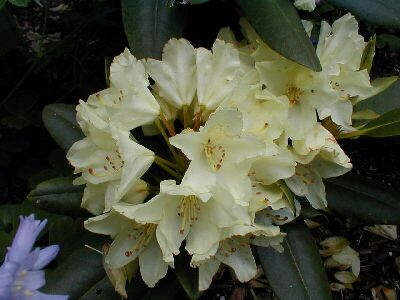
Probably more effort has been expended by Eastern hybridizers toward developing hardy yellow-flowered elepidotes, with less success, than on all other breeding pursuits combined. The goal of the luminous color of 'Crest' combined with Zone 5 hardiness has been elusive. David's early attempts in this area were lackluster, but at least one recent introduction holds promise of being a real breakthrough.
One of the earliest in this group to be introduced (1973) was 'Nile'. A hybrid of white catawbiense x wardii, 'Nile' in my garden presents an attractive plant with nice glossy foliage (albeit somewhat susceptible to leaf spot), but is now budded for the first time in 9 years. A long wait; I hope the flower is worth it. My rating: ?/3/2. Of a similar pedigree (catawbiense 'Catalgla' x 'Crest') is 'Hong Kong', introduced in 1974. This is a similarly attractive plant, again clad in glossy leaves with the same leaf spot problem. Unfortunately, it has been similarly stingy with bloom for me. The flowers, when the plant deigns to favor us, are pale yellow, in some seasons almost cream-colored, with a tiny reddish flare. My rating: 3/3/2.
'Peking', introduced in 1973, represents the next generation of this breeding line: (white catawbiense x 'Hawk') x (catawbiense 'LaBar's White' x 'Crest'). Although this has been freer flowering than the two preceding, the blossoms are smallish and the color still from the standard set by 'Crest'. Nor is the foliage as good as 'Nile' or 'Hong Kong. My rating: 3/2/2.
The introduction of R. yakushimanum into the breeding lines resulted in a more compact plant than the preceding: 'Golden Gala' ('Great Lakes' x 'Good Hope'), introduced in 1981. It has reasonably good habit and foliage, but the flower color, a cream or ivory, could only be termed yellow by a myopic optimist wearing gold-tinted glasses. My rating: 3/3/3.
'Canary Islands', with a complex pedigree, [{white catawbiense x fortunei ssp. discolor x 'Fabia')} x 'Mary Belle'] x 'Peking', was registered in 1985. It has been touted as the "deepest yellow of all" but for me has fallen far short of the advertising hype. Even more parsimonious with its flowers than 'Hong Kong', it has borne exactly ONE truss in the ten years it has occupied a prime site in my garden. The flower color is recognizably yellow, but certainly not the daffodil color illustrated in the nursery catalog. The plant is reasonably presentable, bushy and dense with acceptable foliage that so far has shown resistance to leaf spot. My rating: 3/3/2.
A recent introduction (1991) from the cross [white catawbiense x (dichroanthum ssp. apodectum x 'Loderi White Diamond')] is 'Borneo'. My plant is still too young to evaluate, and has not yet flowered. Stay tuned! The most promising of this group, in my opinion, is 'Capistrano', introduced in 1994. This advanced generation hybrid again has a complex pedigree: [{white catawbiense x (fortunei ssp. discolor x 'Fabia')} x {'Russell Harmon' x 'Goldsworth Orange'}] x 'Golden Gala'. From its yakushimanum ancestor it has inherited a neat, mounding habit and deep green foliage. The full truss of flowers, opening from yellow buds (rather than the peachy-colored buds of 'Hong Kong' and 'Golden Gala') are yellow enough to make the "yellows" of David's earlier efforts look insipid by comparison. Although 1 have only had the plant for two years, I'm willing to assign it a rating of 4/4/4.
Season Extenders: Early and Late
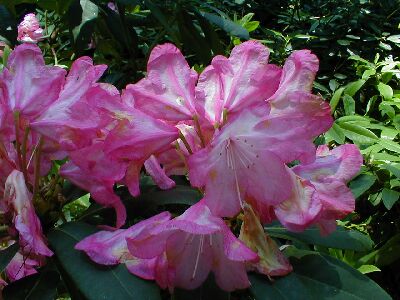
'Spellbinder', a 1975 introduction, resulted from a cross of 'Russell Harmon' x (calophytum x sutchuenense), an attempt to combine the large, early flowers of the pollen parent with the hardiness of the seed parent. From the pollen parent it has also inherited huge leaves (9 to 10 inches long) and a stocky, vigorous habit, with new stems the diameter of a man's finger. Considering its pedigree, the plant is surprisingly dense. My eight-year-old specimen has still not flowered, but again considering the pedigree this is not unexpected; my plant of R. sutchuenense took 14 years to first flowering! My tentative rating: ?/4/3.
To extend the blooming season in the other direction, David developed several late-flowering hybrids. 'Summer Snow' [maximum x (ungernii x auriculatum)], introduced in 1970, is the only one of these to flower for me so far; it bears somewhat loose trusses of very large, widely funnel-shaped flowers of sparkling white, about the third week in June. The large leaves are a good foil for the blossoms. As might be expected from its ancestry, the plant is husky and vigorous, and has already made clear its intention to become a tree. My rating: 4/3/3.
With a plant very similar to 'Summer Snow' in appearance, 'Summer Summit' [maximum x (auriculatum x fortunei ssp. discolor)], introduced in 1984, seems headed in the same direction. The flowers, not yet produced on my seven-year-old plant, promise to add a touch of pink to the summer scene. My rating: ?/3/3.
'Summer Glow' ('Summer Snow' x 'Scarlet Blast'), introduced in 1985, at six years old presents a reasonably good-looking, if not densely foliaged plant. The flower is described as deep pink shading to a paler center. And 'Red River' [maximum 'Mount Mitchell' x ('Mars' x 'Fanfare')], introduced in 1984, should carry the summer color palette into the red range. My ratings for both: ?/3/3.
A Caveat
I'm certain that some of the plants that I have downgraded in the foregoing pages are thriving and rendering good accounts of themselves in other New England gardens. A great deal depends on environmental factors: soil, sun/shade, moisture, root competition, etc. So do not hesitate to experiment with those to which I have assigned low ratings. Who knows, some day you might be able to take me by the hand and point with pride to a neat, compact plant of 'Hindustan' smothered in blossoms! On the other hand, I find it difficult to imagine that winners like 'Janet Blair', 'Bali', 'Casanova' and 'Malta' will be anything less than sensational in your gardens, as they have been in mine.